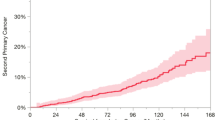Abstract
Of a cohort of 634 children treated from 1942 to 1969 at the Gustave Roussy Institute for a first cancer and alive 5 years after treatment, 32 later developed second malignant neoplasms (SMN). A case-control study was performed to determine the relationship between the dose of radiotherapy received on a given anatomical site for the treatment of a first cancer, and the risk of SMN development at the same anatomical site. Another aim of the study was to analyse the effects of the association of radiotherapy with chemotherapy on the risk of SMN. The 32 cases of second malignant neoplasms were individually matched with one to nine patients of the cohort (a total of 162) who did not develop a SMN after a first cancer, matching on age, sex, type of first cancer and follow-up duration. The doses of radiotherapy delivered for the treatment of the first cancer were retrospectively estimated at the 26 anatomical sites of SMN. When the SMN was a leukaemia, the mean active bone-marrow dose was estimated as a weighted mean of the doses received by 20 bone sites. As compared to anatomical sites in children who had not received radiotherapy, the sites which had received 50 Gy or more had a relative risk of SMN of 5.8 (P less than 0.05). When taking into account the dose received at the site of the SMN, neither the number of fractions nor the type of radiations were related to the risk of SMN. Children who had received chemotherapy had a relative risk of SMN of 2.7 (95% CI: 1.2-6.4), adjusted for the dose of radiotherapy, as compared to those who had not. The relative risk of SMN did not vary with the dose nor the duration of the chemotherapy. Dactinomycin was found to increase the relative risk of second soft tissue and bone sarcomas. Cyclophosphamide was found to be less carcinogenic than the other alkylants. The relative risk of SMN was equal to 2.0 (n.s.) after radiotherapy of more than 25 Gy, to 4.4 (n.s.) after chemotherapy, and to 21.4 (P less than 0.01) after the combination of these two treatments modalities, as compared to patients treated by surgery alone. This study suggests that the oncogenic effect of radiations might be increased by chemotherapy, and that the combination of the two treatment modalities might be one of the major factors responsible for overall risk of SMN.
This is a preview of subscription content, access via your institution
Access options
Subscribe to this journal
Receive 24 print issues and online access
$259.00 per year
only $10.79 per issue
Buy this article
- Purchase on Springer Link
- Instant access to full article PDF
Prices may be subject to local taxes which are calculated during checkout
Similar content being viewed by others
Author information
Authors and Affiliations
Rights and permissions
About this article
Cite this article
de Vathaire, F., François, P., Hill, C. et al. Role of radiotherapy and chemotherapy in the risk of second malignant neoplasms after cancer in childhood. Br J Cancer 59, 792–796 (1989). https://doi.org/10.1038/bjc.1989.165
Issue Date:
DOI: https://doi.org/10.1038/bjc.1989.165
This article is cited by
-
125I Seed implant brachytherapy for the treatment of parotid gland cancers in children and adolescents
Strahlentherapie und Onkologie (2013)
-
Epipodophyllotoxins in the treatment of childhood cancer
Cancer Chemotherapy and Pharmacology (1994)



